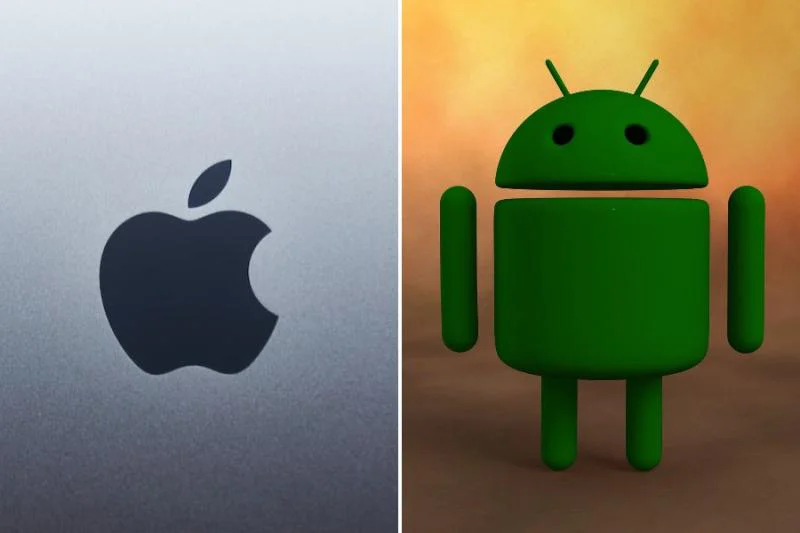Android and iOS are the most popular operating systems for smartphones and tablets. Android, which was made by Google, is open-source, which means that manufacturers and users can change it and use it in different ways. It works on a wide range of devices made by a number of different companies. iOS is a closed-source system that only works on Apple products like iPhones and iPads. It was created by Apple. It gives users a more consistent and controlled experience by making the hardware and software work together better. In short, the main differences between Android and iOS are how open-source or closed-source they are, how well they work with different devices, how customisable they are, and how the user experience is overall.
What is Android?
Android is a mobile operating system (OS) created by Google, based on the Linux kernel, and predominantly designed for touchscreen devices such as smartphones and tablets. It is open-source, allowing developers and manufacturers to modify the software to create individualised user experiences and convert it to a wide variety of devices. This adaptability has contributed to Android’s popularity and position as the world’s most extensively used mobile operating system.
Android provides an extensive application ecosystem, with millions of apps available through the Google Play Store. Due to the platform’s open nature, developers can create and distribute their apps more freely. Through its extensive customisation options, Android enables users to personalise their devices with launchers, themes, and widgets.
Android devices are available in various price ranges and specifications to accommodate multiple user requirements and budgets. This diversity has contributed to the accessibility and global adoption of the platform. Android is also utilised in smartwatches, televisions, automotive infotainment systems, and smartphones and tablets. Google continuously updates Android by introducing new features and security enhancements to maintain its competitiveness and user contentment.
What is iOS?
iOS is an operating system (OS) for mobile devices made by Apple Inc. and is only compatible with iPhones, iPads, and iPod Touch devices. iOS is renowned for its modern, user-friendly interface, seamless hardware and software integration, and emphasis on user privacy and security.
As a closed-source system, iOS provides Apple devices with a consistent and regulated user experience. This ecosystem is highly regulated to ensure optimal performance, stability, and quality control. Apple’s App Store has stringent guidelines and review processes, maintaining a curated selection of apps that adhere to Apple’s criteria.
Although iOS is less customisable than Android, it provides a streamlined user experience and timely software updates, ensuring that devices have access to the most recent features and security upgrades. iOS’s integration with other Apple products and services, such as iCloud, iMessage, and the Apple ecosystem, is a key feature. This interconnectivity provides users with multiple Apple devices with a seamless experience. The platform’s confined nature contributes to its reputation for stability and security, which attracts users who value these characteristics in a mobile operating system.
Difference Between Android and iOS
Android and iOS are the two most widely used mobile operating systems, and each has advantages and disadvantages. In terms of open-source vs closed-source development, device support, personalisation possibilities, app ecosystems, and interoperability with third-party services and goods, Android and iOS couldn’t be more different. Different users will find that each platform has something unique to offer. The fundamental differences between these two frameworks are as follows:
Open-Source vs Closed-Source
Android, developed by Google, is built on the open-source Linux kernel. This makes it possible for users, developers, and manufacturers to change and personalise the software to meet their requirements. Because of its accessibility, Android has spawned various hardware and software. Apple’s iOS, on the other hand, is a closed-source system that guarantees a uniform and regulated user experience across all Apple devices. iOS’s increased reliability and security come at the expense of some personalisation possibilities due to the operating system’s closed nature.
Device Compatibility
A wide variety of devices from companies like Samsung, LG, and even Google’s hardware division are Android-compatible. But Apple’s iPhone, iPad, and iPod Touch are the only devices compatible with iOS. This variety provides a wider selection of smartphones and tablets to meet the varying requirements of users with varying budgets. Its exclusivity promotes seamless hardware and software integration and restricts customers to Apple’s offerings.
Customisation
Android allows users to further tailor their devices with a wide range of customisation choices such as launchers, themes, and widgets. iOS prioritises consistency and ease of use, offering a streamlined user experience with few customisation options.
App Ecosystem
Many apps are available for both platforms, but they take different approaches. Compared to Apple’s App Store, which has more stringent restrictions and review processes to ensure a curated selection of high-quality apps, Android’s Google Play Store gives developers more leeway in creating and distributing apps. The openness or closedness of the underlying platforms accounts for this variation.
Integration and Ecosystem
iOS’s tight integration with the rest of Apple’s offerings makes using the company’s other devices and services a breeze. Using iCloud, iMessage, and other Apple services simultaneously improves the user experience on all of the user’s devices. While Android does provide access to Google services, it does so with less seamless integration due to the wide variety of devices and OEMs supporting Android.







